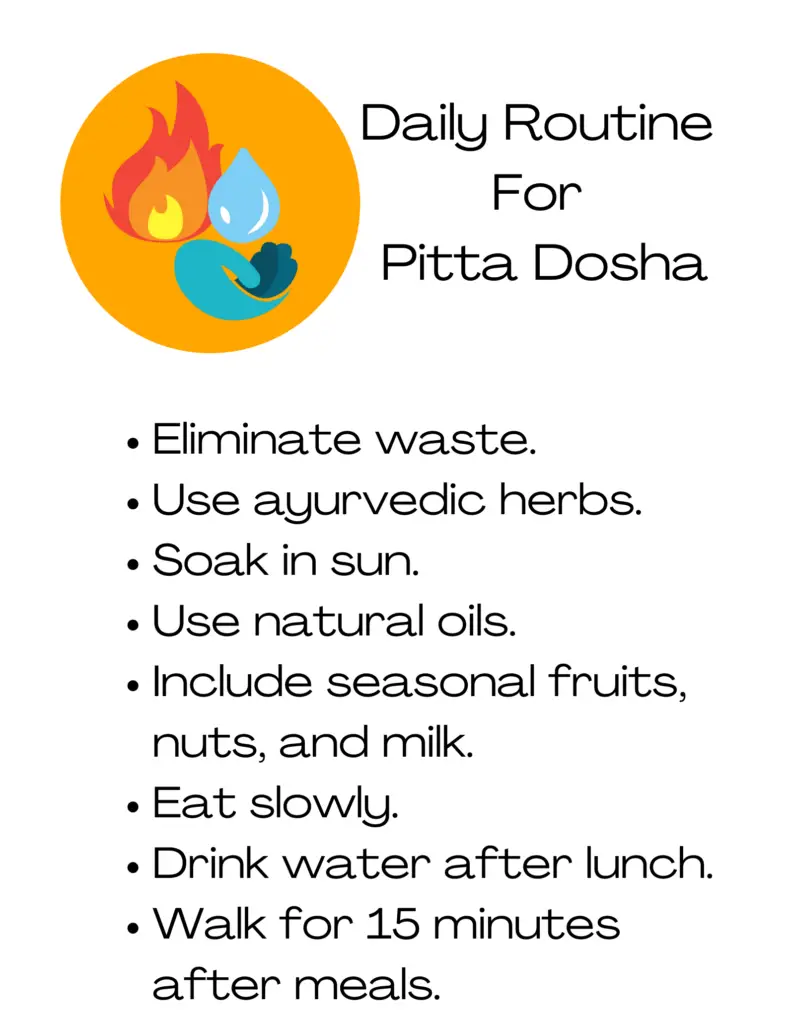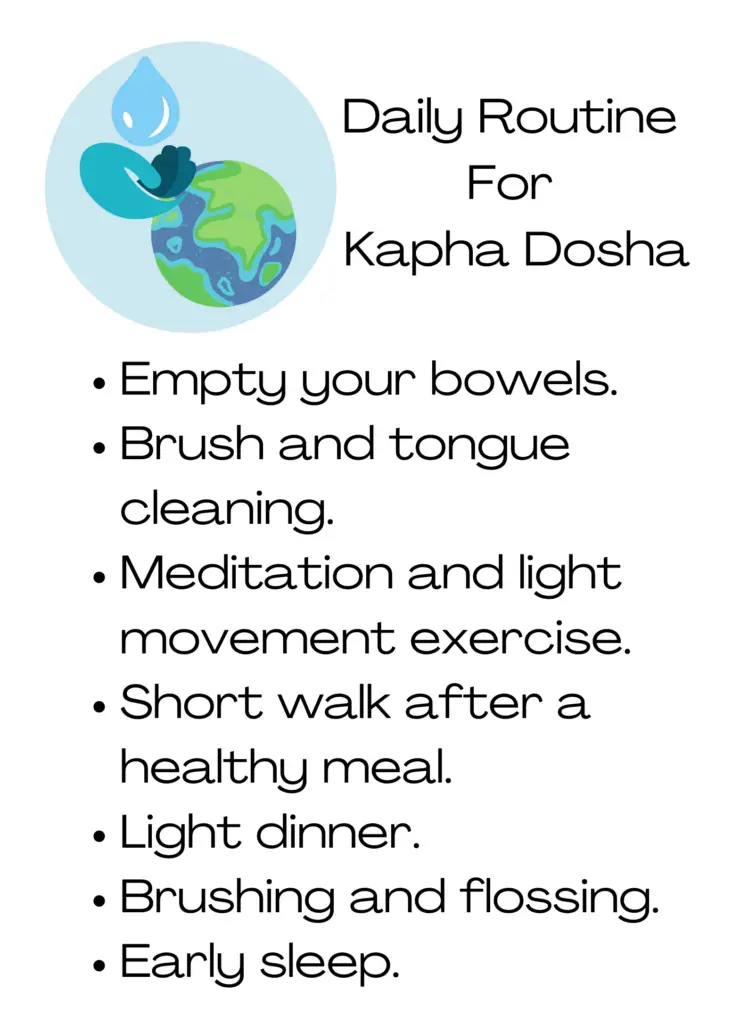How To Start An Ayurvedic Lifestyle
Jump To:

Ayurvedic living is about a journey to self-discovery and mindfulness. This will lead to a greater sense of well-being as well as spiritual growth. Do not feel overwhelmed by all the new concepts and practices. Just take one step at a time. It doesn’t matter if you follow a specific order. Just find what works for you. Then, integrate them one by one into your daily life. Here is a comprehensive guide on how to start an ayurvedic lifestyle according to different Ayurveda doshas.
Pitta Lifestyle
Pitta characters are known for their strong digestion and ability to tolerate almost any food. The food must be mildly spicy, pungent, or salty to calm Pitta’s fire. Pungent, salty, and sour flavors are good for Pitta dosha. These flavors stimulate the stomach juices and the body’s inner fire and provide heat-generating effects. They have a cooling, constricting, and reductive effect.
Pitta people need to eat regularly, as they can easily lose their equilibrium and the heated element could prevail. Moderation is therefore the key. The Pitta period dominates summer so, just like other doshas in the world, Pitta characters need to pay attention during warmer months to their internal cooling.
Daily Routine For Pitta Dosha

Morning:
Pitta dosha needs to get up before the sun rises. This not only helps to develop a routine but also helps people with sleep disorders. Warm water is good for detoxing the body. To set the mood for the day, meditate for 10 minutes or do some light yoga poses or exercises. It gives you energy and vitality for the day ahead.
- Eliminating or expending waste is an essential part of a healthy morning routine.
- You can use ayurvedic herbs such as Triphala to naturally smoothen the process. Triphala is a laxative that purifies the entire colon, intestine, and surrounding areas.
- To retain as much natural vitamin D as possible, take a bath and soak in the sun for at most 10-15 minutes.
- After that, you can take a refreshing shower with natural oils like lavender or sunflower. These oils bring positivity and help you face your daily challenges.
- Make sure you eat a healthy, nutritious breakfast that includes seasonal fruits, nuts, and milk.
- To avoid aggravating pitta, you should make sure that you complete your daily morning-to-evening chores. If you are feeling stressed or under pressure, the Ayurveda pitta pacifying daily routine will work well.
Afternoon:
Mid-day is an important part of the pitta pacifying day’s routine. The digestive fire is stronger and nutrients are more evenly distributed. Lunch should be the largest meal of the day. It should include seasonal vegetables, fruits, and legumes, as well as rice, lentils, legumes, lentils, lentils, and rice.
- Slow eating is good for digestion.
- Talking, reading, or driving while eating is not a good idea. When eating lunch, your attention should be on the food and the digestion process.
- To help your food settle quickly, ensure you sit straight up for at least five minutes after lunch.
- Drinking water after lunch will help to calm the body and soothe it.
- Ayurveda advises that you should not exercise or do any strenuous weight training late in the afternoon or evening, as this will ignite the pitta spirit.
Evening:
After a long day of work, the evening pitta should be easy and light. You should have a light meal that includes soups and salads. After dinner, you should sit down for five minutes to allow the food to settle.
- To aid digestion, take a leisurely, slow walk for 5 to 15 minutes. This will help you to feel calm and relaxed.
- As mentioned, avoid exercising after sunset. Instead, read inspirational books.
- A few drops of essential oils such as rose or lavender can be added to a warm, relaxing bath before you go to bed. It is better to go to bed early than 10 p.m. for those with pitta dosha.
- Individuals suffering from aggravated pitta should always try abhyanga (self-oil massage). This helps to keep the mind and nerves calm, and peaceful, and also reduces dryness.
- Ayurveda says that the skin is the primary place of pitta dosha. To maintain proper blood circulation, it is important to regularly cleanse, moisturize, and scrub the skin as part of the pitta dosha’s daily routine.
- Abhyanga is said to have healing properties such as increased blood circulation, detoxification of skin cells, and stimulation of the nerves.
Vata Lifestyle
Vatas are creative, communicative, and full of ideas. Although they are naturally enthusiastic, they can easily become distracted by new and better things after a while. They are quick to pick up and quickly forget. They have less willpower. People with a Vata constitution, among other things, have a delicate bone structure. They also don’t carry much weight. Their skin is often dry and rough. They are very active physically. Variable appetite and digestion. Vatas love sweet, salty and sour foods. They often have cold hands and feet.
Daily Routine For Vata Dosha

Morning:
Vata dosha people don’t need to get up early every morning. However, they should ensure that they wake up at the same hour each day. This helps to establish a routine and allows for eight hours of sleep. A good night’s sleep is essential for the health of your body and organs. Vata people tend to be overexercised and push themselves physically so they must take a break from the stress and relax.
- Warm water is the first step to a successful Vata daily regimen. This will help to flush out toxins from the body. You can add a few drops of lemon juice or organic honey.
- Next, sit down for 10-15 minutes of meditation or prayer. This will help you to shut off worldly worries.
- To stay calm and happy throughout the day, you should feel positive and happy. This will set the stage for a happy and fulfilled day.
- Massage the body daily with a nourishing oil such as almond to increase blood circulation and bring warmth.
- To feel clean and fresh, make bathing a Vata a daily practice.
- Next, do a 20-25 minute Vata balanced yoga routine. This is equivalent to light exercise or brisk walking. It strengthens the body and makes it stronger.
- After that, eat a healthy breakfast before 9:30 AM. To gain energy, one must include cereals and milk along with fruits, nuts, and vegetables in every morning meal.
- To relax and perform daily chores effectively, it is important to take breaks between tasks. Avoid straining yourself and don’t multitask too much.
- Keep drinking plenty of warm liquids throughout the day, such as soups, hot teas, and water. This will help to prevent dehydration.
Afternoon:
To maintain balance, it is important to have a daily Vata pacifying routine that you follow every day. To make sure that your body is used to the meal, it is important to set a time for lunch. Lunch should be taken by 12.30 pm to ensure that nutrients are evenly distributed throughout the body. You can enjoy lunch in a peaceful setting, away from traffic and television.
- Warm foods should be fresh, seasonal, and properly prepared.
- Avoid canned and junk food as much as possible. To give your mind rest, take a break from eating for at least five to ten minutes.
- After eating, go for a brisk 10-minute walk to ensure that the food has been properly digested.
- Vata constitution people tend to feel more energetic after eating. Therefore, it is important to slow down and calm your senses to help digestion.
- For those who are at home, you can take a 20-25 minute nap to relax and feel calm.
- Keep your workplace or home warm. Vata dosha can be sensitive to air movement so avoid sitting near ventilation shafts.
Evening:
To feel relaxed and stress-free, the Vata pacifying daily ritual includes another meditation before sunset. To soothe your senses, it is important to take a moment for yourself. Meditation can help calm the mind, as Vata dosha is hypersensitive.
- A light meal of soups or salads is a good idea. It’s best to share it with your family. For faster digestion, you should sit down for a while after eating. Then, take a 5-minute walk.
- To maintain a balanced constitution, it is best for Vata individuals to not be too energetic, frenzied, or work-oriented in the evenings.
- To feel happy and unperturbed, always read a light-hearted book or inspiration.
- It is recommended to take a warm bath before you go to bed to help with pacifying Vata.
- Keep your eyes closed at 10 p.m. every day.
Kapha Lifestyle
Kapha energy is a characteristic of people who work well and are thorough. Although they can appear slow and ponderous to others, Kapha types are known for their extraordinary endurance and strength. When a Kapha type sets a new goal, they persevere until they achieve it. Kapha people are passionate about eating, so they tend to become overweight throughout their lives. Kapha people value inner peace, harmony, and tranquility above all else. Kaphas can appreciate the small things in life and are able and willing to try new things. They value private joy in a stable relationship, healthy children, and loyal friendships. These are the things that bring them inner happiness, security, and peace of mind.
Daily Routine For Kapha Dosha

Morning:
One thing that stands out in this is the best time to create a deep and meaningful connection with yourself. It is important to remember that even though you are a Kapha it is not the right time for children, the elderly, pregnant women, and those with disabilities to get up.
- During this time, empty your bladder and bowels. Morning elimination is an important part of the Kapha pacifying routine.
- To remove bacteria and other toxins, you should follow simple hygiene practices such as regular tongue scraping.
- Regular brushing and tongue cleaning are also helpful in stimulating and cleansing your digestive tract.
- Warm water can also be used to cleanse and moisturize the skin. Warm water can help relieve constipation in the Kapha dosha.
- Meditation or prayer can help calm the mind.
- Pranayama, or breathing exercises, can be used to calm the mind and help with Kapha.
- To pacify Kapha, meditation and light movements in the morning are very helpful.
- Walking and running in the morning is a great way to exercise.
Afternoon:
Although most tasks of daily Kapha are done in the morning, there are a few things that can still be done at noon to increase the daily benefits. It is important to establish a time that works for you. This helps with digestion and distributes nutrients evenly.
- Ayurveda recommends that lunch be the main meal of each day.
- After lunch, you should take a short walk. Then, rest for a bit.
Evening:
The evening routine is very important for the Kapha. The evening ritual should be similar to the morning routine. It should include taking care of yourself. The daily Kapha pacifying routine will not only boost self-worth but also improve one’s mental and physical health.
- Don’t complicate your daily routine, but instead focus on hygiene and detoxification.
- It is important to properly brush your teeth, floss them, and moisturize them before you go to bed.
- You should also sleep at a set time to ensure that you get enough rest.
How can I have a Ayurvedic lifestyle?
Rules for an Ayurvedic Diet Select Foods for Your Dosha Type.
- Eliminate Snacks.
- Eat Until Satisfied, Not Full.
- Consume Whole, Fresh Foods.
- Include All Six Tastes at Every Meal.
- Reduce Ice Cold Foods and Beverages.
- Eliminate Distractions While Eating.
- Stop Eating Three Hours Before Bedtime.
What is an Ayurveda diet?
The Ayurvedic diet is a meal plan based on the principles of Ayurvedic medicine, a form of traditional medicine dating back thousands of years. The diet involves eating or restricting certain foods based on your dosha, or body type, which is claimed to boost weight loss and support mindfulness.
Can you eat meat in Ayurveda?
In Ayurveda, a little of anything is considered medicine and too much is considered poison. This rule stands for meat as well. In the ancient texts of Ayurveda, each animal product is defined by quality and meat is recommended as therapy for many ailments.
How do I know my body type in Ayurveda?
The ancient Indian science of healing ‘Ayurveda’ defines your body into three types – Vata, Pitta and Kapha. The body type of a person depends on their physical and emotional attributes. To get the maximum benefit from the daily diet you consume or the treatment you take when ill, you must know your Ayurveda body type.
What should we eat in breakfast according to Ayurveda?
Easy recipe for an Ayurvedic breakfast porridge Brown your chosen cereal (e.g. oats, spelt, buckwheat) in coconut oil, ghee or other fat (recommended cereals for Kapha types: rye, spelt, buckwheat, millet/for Pitta types: spelt, wheat, oat, barley/for Vata types: wheat, quinoa, rice, oat)
What does Ayurveda say about eggs?
Ayurveda prohibits eating eggs because it aggravates physical and emotional fierceness. Eggs are strongly discouraged and completely avoided since several centuries. Just like no meat in Ayurveda, no eggs in Ayurveda have many perspectives. Eating eggs create a veil to develop spirituality.
How many times should we eat in a day according to Ayurveda?
Five meals per day is a good goal for a person with a vata constitution. However, these meals should not be very large. The strength of the digestive fire in a person with a vata nature or imbalance is not very strong and eating larger amounts of foods will lead to excessive gas and bloating. Check out Ayurveda eating times.
What is the main goal of an Ayurvedic treatment?
The concepts of universal interconnectedness, the body’s constitution (prakriti), and life forces (doshas) are the primary basis of ayurvedic medicine. Goals of treatment aid the person by eliminating impurities, reducing symptoms, increasing resistance to disease, reducing worry, and increasing harmony in life.
What are the benefits of Ayurveda?
Benefits of Ayurveda Weight Loss and Maintenance.
- A healthy diet and modification in lifestyle habits through Ayurvedic treatments help shed excess body fat.
- Glowing Skin and Hair.
- Say Goodbye to Stress.
- Reduce Inflammation.
- Cleanse the Body.
- Lower Blood Pressure, Cholesterol, and Symptoms of Illness and Diseases.
